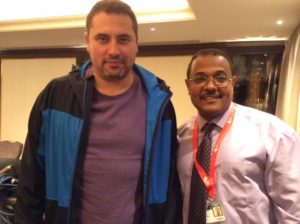
Our screening editor, Dr Khalid Ali (Khalid.ali@bsuh.nhs.uk), here writes about the importance of Romanian director Radu Jude’s new film Scarred Hearts (Romania, 2016) and interviews him at the London Film Festival in the podcast included below.
Each year on the 24th of March, several organizations around the world celebrate ‘International Tuberculosis Day’. It serves as a timely reminder that TB still remains an international epidemic claiming the lives of an estimated 1.4 million people, making TB one of the top 10 fatal diseases, and the emergence of 480,000 multidrug-resistant TB cases annually according to the Global Health Observatory data report- 2015. Before ‘Streptomycin’ was discovered as an effective anti-tuberculous drug in 1944, TB was a devastating disease with an inevitable death sentence. Radu Jude, award winning Romanian film director, revisits the TB epidemic in the early twentieth century in Scarred Hearts. The film is based on the life of Max Blecher (1909-1938), a Romanian writer who wrote the book Inimi Cicatrizate based on his own affliction with TB.
Scarred Hearts is a close examination of the life of Emanuel (Lucian Tedor), a Jewish Romanian young man in his twenties from a privileged background in the turbulent times of WWII, who falls ill with Pott’s disease (TB of the spine). Emanuel is admitted to a sanatorium, were he spends years bed-ridden, contemplating life, love, and illness. While meditating and writing his books and essays, Emanuel meets and befriends fellow patients and nurses. His encounters with the sanatorium’s resident doctor are short and traumatic; one such encounter happens when the doctor evacuates an abscess from his back with little analgesia, if any. The days go by slowly in his confined solitary world, while some nights are livened by ‘carnal activities’ with a young, female nurse, and another patient affected by TB. With the war exploding outside, boredom and melancholy set in in the dark corners of the sanatorium. The budding companionship and friendly exchanges with other inpatients over smoking, drinking alcohol, and playing cards, make the sanatorium a safe refuge for creativity in writing literature and composing essays, human interactions, friendships, and love. Some patients even decide to stay in the hospital indefinitely, and take up voluntary roles caring for other patients, showing altruism and human sacrifice. Self-management in chronic conditions is a relatively new concept in medical literature; however, Emanuel in 1930s Romania embodied the essence of self-management in ‘surviving a bed-bound existence with resilience and hope’. The socio-economic dimension of TB in today’s world plays an important factor in making it a universal public health and social challenge. Co-ordinated health and social interventions are as much needed today as they were in the mid 1930s.
Throughout history, TB has been given several names: consumption disease, The White plague (a seventeenth-century TB epidemic in Europe and North America), Phthisis (a term which appeared in Greek literature around 460 BC, and was used by Hippocrates), Scrofula (TB of the lymph glands), and Pott’s disease. It was also referred to as the ‘Romantic disease’ as a lot of its sufferers were young adults at the time of the Romantic movement in European art, literature, and philosophy. Throughout history several notable literary figures suffered from TB; Jane Austen, Emily Bronte, John Keats, Anton Chekov, Franz Kafka, Khalil Gibran, and George Orwell are some examples. However, Max Blecher stands out in documenting his journey with TB in Inimi Cicatrizate.
It is interesting to note that Max Blecher was studying medicine in Paris when he had spinal TB. He was forced to abandon studying medicine, and become institutionalised in hospital settings until his untimely death at the age of 28. As a medical student and a writer, he had several qualities which are essential in both vocations; keen observation, building a rapport with those around him by actively listening to them, and transforming all those interactions and experience into a coherent form of story-telling. It goes without question that ‘empathy’ was a driving force in his analysis of the physical and emotional facets of illness. He was indeed bed-bound, but his eyes and ears were wide-open to the suffering and misery around him. Documenting his thoughts and philosophy in writing might have helped him stay sane, hanging on to some form of well-being in the bleakest of circumstances. Mother Theresa once said ‘The biggest disease today is not leprosy or tuberculosis, but rather the feeling of being unwanted’. Reminding ourselves on Friday 24th March 2017 of the global impact of TB, its sufferers are no longer alone or unwanted.
Listen to the interview with Radu Jude, director of Scarred Hearts:
[soundcloud id=’311022040′ height=’false’]